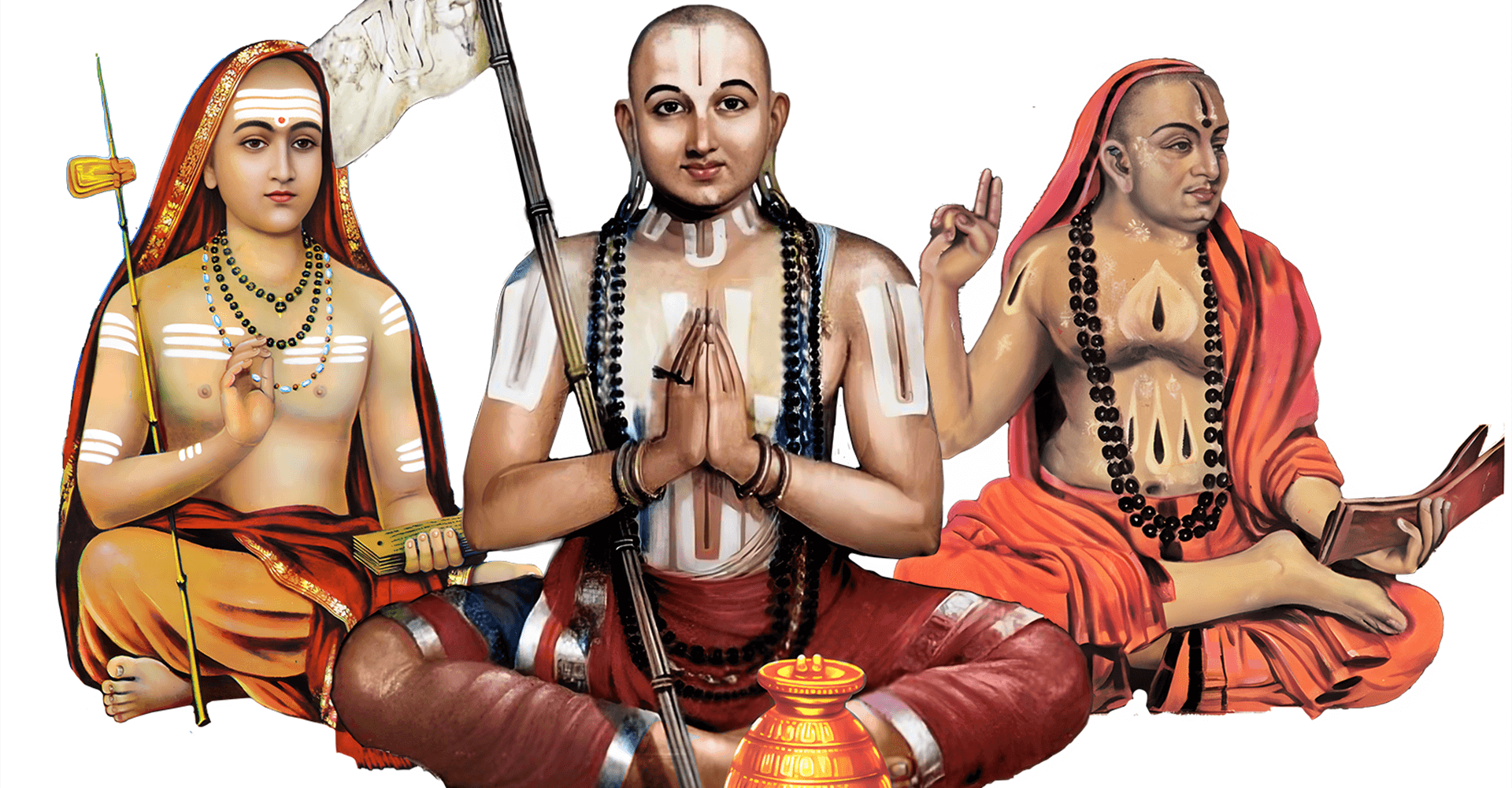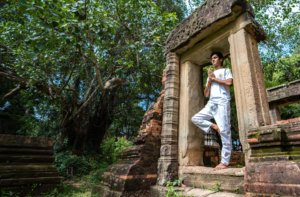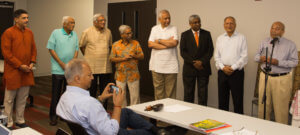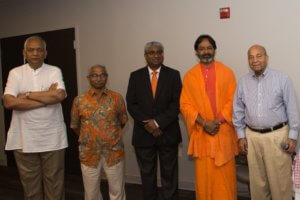
Samanvaya (Reconciliation) of Advaita, Viśiṣṭādvaita, and Dvaita
Vedānta is the corpus of knowledge at the end of the Vedas. These are the Upaniṣad. These are the core texts capturing revelations by Ṛṣis. Bhagavad Gītā as part of Mahābhārata is the second important text to put the Upanishadic knowledge in the context of human life. The Brahma Sūtra written by sage Bādārayaṇa summarizes the teachings of Vedānta in the form of short statements. Upaniṣad, Bhagavad Gītā, and Brahma Sūtra are called “Prasthānatrayī” – the trinity of Hindu thought. Various ācāryas have been writing the interpretations of the Upaniṣad, Bhagavad Gītā, and Brahma Sūtra giving rise to multiple schools of Vedānta. Upanishadic thought means the relationship of jīva (living beings), jagat (the physical world around the living beings – matter), and Īśvara (Sat-Cit-Ānanda Ātman) with each other. For these three entities (jīva, jagat, Īśvara) various possibilities of relationships emerge. Out of those, the following 3 are the most prominent-
- Jīva, jagat, and Īśvara as being one (abheda) – nondual or Advaita.
- Jīva, jagat, and Īśvara are fundamentally different and do not merge into each other (bheda)– dual or Dvaita.
- Jīva, jagat, and Īśvara being one under specific conditions and being different under specific conditions – Viśiṣṭādvaita.
Sri Śaṅkarācārya (8th century) is the most prominent proponent of Advaita. Sri Rāmāṉujācārya (11th century) was for Viśiṣṭādvaita and Sri Madhvācārya (13th century) was the proponent of Dvaita. Each of them humbly says that they are merely interpreting the Vedānta and Bhagavad Gītā and not the founders of each school. As per them, their view is firmly established in Vedānta and supported by Bhagavad Gītā. If we look at the core principles of each of the schools, it feels that each school is showing a new path different from each other. Our common experience is that Hindus subscribe to these schools and vehemently ground themselves in their schools. Śaiva, Vaiṣṇava, and Śakta Saṃpradāya worship Śiva, Viṣṇu or Kṛṣṇa, and Goddess Śakti respectively in various forms. It means each of the forms for their Saṃpradāyas is the ultimate form of truth.
A historical perspective shows that Viśiṣṭādvaita came out as a critic of Advaita and later Dvaita came out as a critic of both Advaita and Viśiṣṭādvaita. This gives a view that the three schools of Vedānta have so many differences that it is not possible to reconcile those as consistent with one another.
After understanding the core tenets of each school and considering that Advaita came first, followed by Viśiṣṭādvaita and then Dvaita, I feel that each of the schools of Vedānta is a continuation of the same thought of achieving Muktī – freedom from suffering and freedom from the cycle of rebirth. Each ācārya guides us to take the path that they propounded in the light of the Upaniṣad and Bhagavad Gītā (only Sri Śaṅkarācārya wrote a commentary on Brahma Sūtra).
Evolution of Vedic Thought
The early Upaniṣads were revealed to ṛṣis and were written 7,000 years ago. The original Vedic thought originated at least 1,000 to 1,500 years before the Upaniṣads. The original Vedic thought worshiped Indra, Varuṇa, Soma, and other devatas of nature. Various rituals and sacrifices were at the core of the Vedic life and were meant to deliver a happy and prosperous life in terms of progeny and wealth during life and svarga (after life). Slowly Vedic thought evolved beyond the rituals and sacrifices. Vedic thought evolved to describe
the limits of the rituals and sacrifices to achieve truth and peace – the Sat-Cit-Ānanda Ātman. Muṇḍaka Upaniṣad 1.2.12 says –
परीक्ष्य लोकान् कर्मचितान् ब्रह्मणो निर्वेदमायान्नास्त्यकृतः कृतेन ।
तद्विज्ञानार्थं स गुरुमेवाभिगच्छेत् समित्पाणिः श्रोत्रियं ब्रह्मनिष्ठम् ॥ १२ ॥
A mature human being (in worldly affairs) resorts to renunciation after examining the worlds, acquired through karma, with the help of this maxim: the uncreated (eternal/reality) is not accomplished by karma. For knowing that reality he should go to the Guru with samidhā in hand.
It is a common experience of any mature person who has some experience of the world, that any amount of fulfillment of desires does not generate a lasting peace and freedom from suffering. The desires keep changing and new desires keep developing. So, in such situations, the mature person surrenders to the Guru who is well-versed in Brahmavidyā. This Upanishadic thought did not hinder the rituals and sacrifices but provided a new meaning of Mukti. Now it was no longer related to going to svarga by practicing sacrifices but freedom from suffering in human life and freedom from the cycle of birth-growth-death. Taittirīya Upaniṣad (Brahmānanda Vallī) 2.1.1 says- ब्रह्मविदाप्नोति परम् । तदेषाऽभ्युक्ता । सत्यं ज्ञानमनन्तं ब्रह्म । यो वेद निहितं गुहायां परमे व्योमन्। सोऽश्नुते सर्वान् कामान् सह ब्रह्मणा विपश्चितेति॥ The knower of Brahman attains the highest. Here is the verse about that very fact: “Brahman is satya, jñāna and ananda. He who knows that Brahman as existing in the intellect, lodged in the supreme space in the heart, enjoys, as identified with the all-knowing Brahman, all desirable things simultaneously.” Here Vedānta reveals that path of freedom from suffering in human life while continuing to follow worldly engagements. The human needs to understand his or her connection with the physical world, other living beings, and the ultimate truth – Brahman. Various Upaniṣads provide different models of the origin of jagat (physical world), jīva (all living creatures), and Brahman. Chāndogyopaniṣad in 6.2.3 describes बहु स्यां प्रजायेयेति – It (Being, or Brahman) thought: ‘May I be many; may I grow forth.’ So, Brahman had a thought and it decided to become many and from there, the origin of jagat and jīva started. This is like Nāsadīya Sūkta (Ṛgveda 10.129) कामस्तदग्रे समवर्तताधि मनसो रेतः प्रथमं यदासीत्। – “In the beginning, desire descended on It (Brahman), that was the primal seed, born of the mind.” Brahman had a desire to create the jagat and jīva. This desire can be termed as māyā the Śakti that created everything including time and space. This is explained in Muṇḍaka Upaniṣad in 1.1.7 as – यथोर्णनाभिः सृजते गृह्णते च यथा पृथिव्यामोषधयः संभवन्ति। यथा सतः पुरुषात् केशलोमानि तथाऽक्षरात् संभवतीह विश्वम् ॥ “As the spider puts out and gathers in, as herbs spring up upon the earth, as hair of head and body grow from a living man, so here all is born from the Immutable (i.e., Brahman).” In summary, Vedānta through various Upaniṣads reveal the connection between the physical world (jagat), living beings (jīva), and Īśvara (Brahman). Now comes the Bhagavad Gītā. Ācārya Madhusudana Saraswati praises Bhagavad Gītā in his Gītā dhyānam – सर्वोपनिषदो गावो दोग्धा गोपालनन्दनः| पार्थो वत्सः सुधीर्भोक्ता दुग्धं गीतामृतं महत्|| “All the Upaniṣads are the cows and Kṛṣṇa is the one who milks them. Arjuna is the calf; the devotees are the consumers of the great nectar of Gita.”. Bhagavad Gītā provides a systematic path to understanding the Upaniṣads and implementing the revelations of the Upaniṣads in the daily life of devotees to free oneself from suffering. Kṛṣṇa – the Īśvara – incarnation of Brahman – says following ते तं भुक्त्वा स्वर्गलोकं विशालं क्षीणे पुण्ये मर्त्यलोकं विशन्ति । एवं त्रयीधर्ममनुप्रपन्ना गतागतं कामकामा लभन्ते ॥ ९-२१ ॥ “After having enjoyed that vast svargaloka, their puṇya is exhausted, and they re-enter into martyalokam (human world). Thus, those who follow the rituals and sacrifices prescribed in the three Vedas – merely the Vedic rites and duties; are desirous of pleasures. They attain only the state of going and returning (from svarga to this world – rebirth cycle), but never that of mokṣa.” In 5.29 Kṛṣṇa says – भोक्तारं यज्ञतपसां सर्वलोकमहेश्वरम्। सुहृदं सर्वभूतानां ज्ञात्वा मां शान्तिमृच्छति।।5.29।। “One attains Peace by knowing Me who, as the great Lord of all the worlds, am the enjoyer of sacrifices and austerities, (and) who am the friend of all creatures.” With multiple such references across Bhagavad Gītā, it becomes clear that Kṛṣṇa provides clarity on Mukti. If one follows the Vedic rituals and sacrifices, one will reach svargaloka but will eventually have to reenter jagat. If one worships Kṛṣṇa, one will attain peace – peace from cycles of birth, growth, death, and suffering. In other words, this reflects the entire Vedic teaching. The Pūrva Bhāg of Veda (Mīmāṃsā) deals with the rituals and sacrifices that take one to svarga and the evolution of Vedic thought through Upaniṣads provides the path of true happiness – Sat-Cit-Ānanda. So, are these 2 separate paths for the devotees? The answer is no. The path that the devotee takes depends on his or her readiness of mind through three Guṇas (satva, rajas, tamas) and free will – the choice of actions one wants to exercise while choosing the path. Now with this background, we can go back to the three ācāryas.
Vedānta Schools: Sri Śaṅkarācārya, Sri Rāmāṉujācārya, and Sri Madhvācārya
Vedānta School | Relation of Brahman, Jagat and Jiva | Example, metaphor |
Advaita Adi Śaṅkarācārya 8th Century | Brahman is Creator of Jagat & JivaJiva & Jagat are same as Brahman | Clay and pots. Pots are just different forms of clay, but clay remains the same across the pots. All pots are clay. |
Viśiṣṭādvaita Sri Rāmāṉujācārya 11th Century | Brahman is Creator of Jagat & JivaBrahman, Jiva & Jagat are separate, but Jiva shares the same nature as Brahman and there are many Jivas. | Flames and sparks. Sparks originate from flame having the same nature as flame, yet flame is separate from sparks. Sparks don’t become flame. |
Dvaita Sri Madhvācārya 13th Century | Brahman is Creator of Jagat & JivaJiva & Jagat are separate from Brahman. Jiva & Jagat are separate from each other | Prapañca – 5 relationships in jīva, jagat, and Brahman |
Note that none of the Ācārya says that they are teaching their “school”, but they say that they are teaching Vedānta. It becomes puzzling and unsettling to know that each of the Ācāryas has interpreted the same Upaniṣad and Bhagavad Gita differently in many aspects while having few commonalities.










